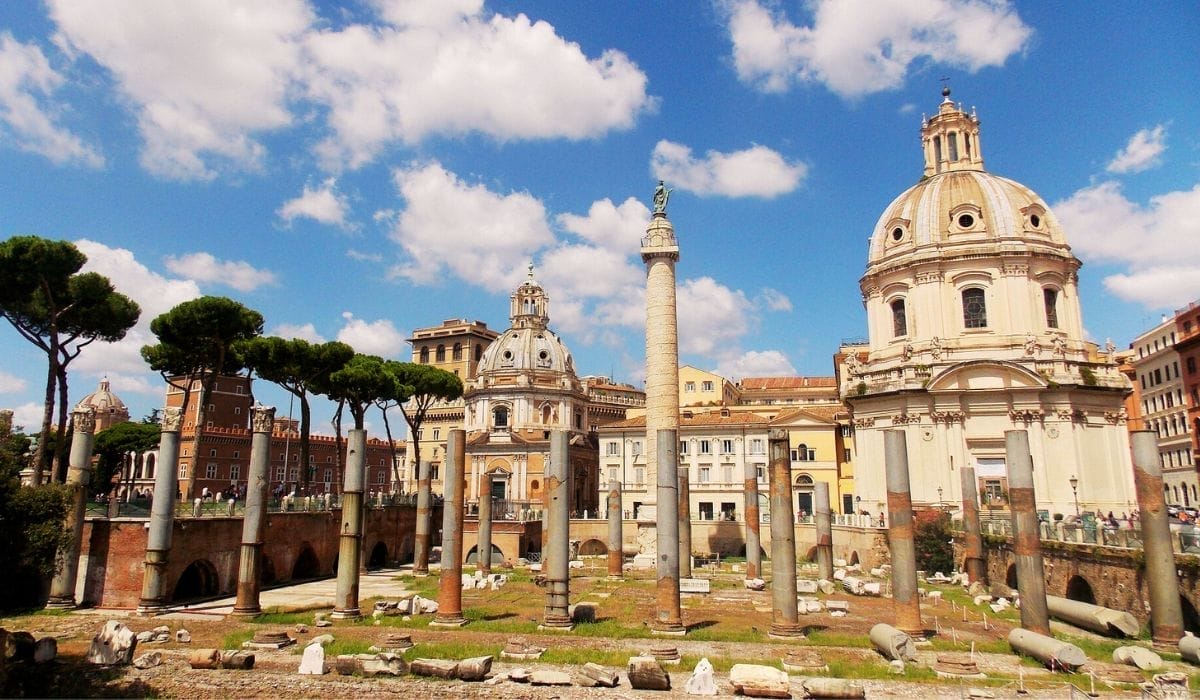
Trajan’s Column in Rome: How to Visit the Colonna Traiana (History, Access & Tips)
Few monuments capture the spirit of ancient Rome quite like Trajan’s Column, a breathtaking marble pillar that has watched over the Eternal City for nearly 2,000 years.
Standing proudly just steps from Piazza Venezia, between the Via dei Fori Imperiali and the Colosseum, the Colonna Traiana immediately draws your attention. Its intricate spiral frieze, stretching almost 200 meters, tells the dramatic story of Emperor Trajan’s victories over the Dacians, a true masterpiece of Roman art and storytelling carved in stone.
Today, this monument remains one of Rome’s best-preserved ancient wonders. It’s not only a symbol of the empire’s power but also a fascinating stop in the heart of the Imperial Forums, and best of all, you can admire it for free, any time of day.
In this guide, you’ll find everything you need to know to visit Trajan’s Column in Rome:
- where it’s located and how to get there,
- why it was built,
- the secrets behind its famous spiral relief,
- and the top nearby sights to explore after your visit.
Ready to step back in time to the golden age of the Roman Empire? Let’s dive in.
Contents
- 1 What is Trajan’s Column?
- 2 Practical Information for Visiting Trajan’s Column
- 3 Why Was Trajan’s Column Built?
- 4 The Incredible Details of Trajan’s Column
- 5 A Triumphal and Funerary Monument
- 6 History of Trajan’s Column Through the Centuries
- 7 What to See Near Trajan’s Column in Rome
- 8 FAQ About Trajan’s Column in Rome
What is Trajan’s Column?
If you stroll near Piazza Venezia, it’s impossible to miss Trajan’s Column in Rome. Standing almost 40 meters high, this majestic marble monument rises proudly from the ruins of the Forum of Trajan, a perfectly preserved reminder of the power and glory of the Roman Empire.
The Colonna Traiana, as it’s known in Italian, is a triumphal column built in the early 2nd century AD to celebrate Emperor Trajan’s victories over the Dacians (in modern-day Romania). Its spiral frieze, carved directly into the marble, winds around the shaft like a giant illustrated scroll, depicting in incredible detail the epic military campaigns of Rome.
It’s also one of the few ancient remains still standing from the Forum of Trajan, once a vast complex of temples, libraries, and public squares built to honor the emperor. Today, the column still dominates Via dei Fori Imperiali, perfectly placed between the Colosseum and the Victor Emmanuel II Monument.
Even though you can’t climb inside Trajan’s Column, it’s free to visit and simply looking up is enough to admire the hundreds of sculpted figures spiraling toward the sky. A true journey back in time, right in the heart of Rome’s historic center.
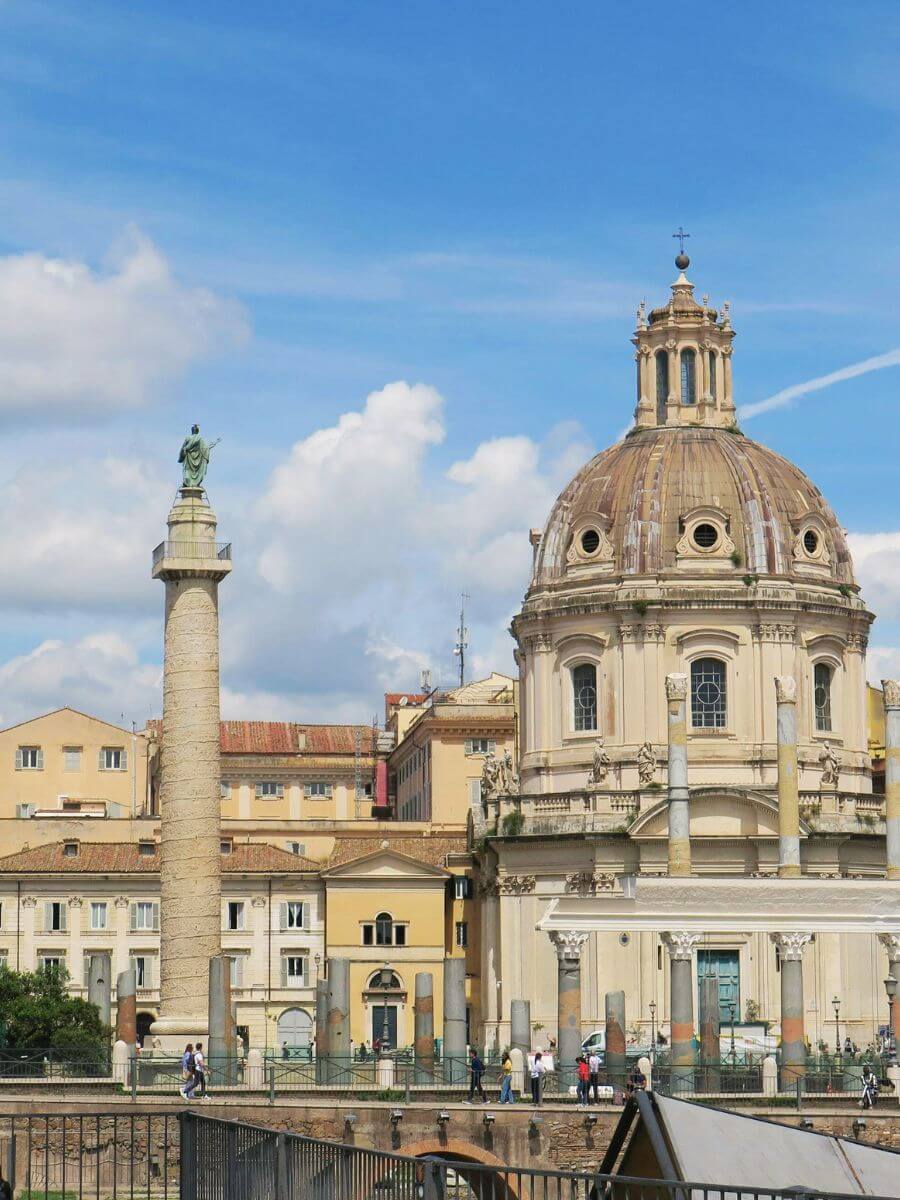
Practical Information for Visiting Trajan’s Column
If you want to admire Trajan’s Column in Rome without missing a thing, this section is for you! Here’s everything you need to know to find it easily, get there without hassle, and make the most of your visit.
Where is Trajan’s Column located in Rome?
Trajan’s Column stands right in the historic center of Rome, within the Forum of Trajan, just beside Piazza Venezia.
- Address: Via dei Fori Imperiali, 00187 Roma RM, Italy.
It’s located halfway between the Colosseum and the Victor Emmanuel II Monument (Altare della Patria), you couldn’t ask for a more central spot!
You can see the Colonna Traiana directly from the street, standing gracefully between two beautiful Baroque churches: Santa Maria di Loreto and Santissimo Nome di Maria al Foro Traiano.
How to Get to Trajan’s Column in Rome
Column of Trajan is very easy to reach thanks to Rome’s excellent public transport network:
- Metro: Line B, get off at Colosseo station (about a 10-minute walk).
- Bus: Stop at Piazza Venezia, one of the city’s main hubs, served by many lines (40, 60, 64, 70, 85, 170…).
- Tram 8: If you’re coming from the Trastevere district, get off at Argentina and walk for about 7–8 minutes.
- On foot: From the Colosseum, it’s about a 15-minute walk along Via dei Fori Imperiali, a stunning stroll with views of the Roman Forums all along the way.
Travel tip: The column is visible from outside, so there’s no ticket or opening hours. You can admire it freely any time of day.
Tips for Enjoying Your Visit to Trajan’s Column
To really appreciate the fine details of Trajan’s Column, try to avoid visiting during the hottest hours of the day (between 12 p.m. and 3 p.m.), when the strong light makes the reliefs harder to see.
Best times to visit:
- Early morning – the side lighting beautifully highlights the carvings.
- Late afternoon – a warm golden glow enhances the sculpted scenes.
- At night – it’s pure magic! The column is softly illuminated, revealing every figure in the marble. It’s one of the most beautiful free sights in Rome.
Best Spots to Admire Trajan’s Column
- From Via dei Fori Imperiali, you have a perfect direct view of the column.
- From the terrace of the Victor Emmanuel II Monument, you can enjoy a stunning panoramic view of the forum and the column below.
- If you love photography, go right after a rain shower, the wet marble captures the light beautifully.
And if you’d like to understand the story carved into the stone, consider booking a guided tour or using an audio guide app dedicated to the Imperial Forums. It’s the best way to follow the episodes of the Dacian Wars, without straining your neck!
Why Was Trajan’s Column Built?
Trajan’s Column in Rome is far more than just an ancient monument, it’s a powerful symbol of imperial glory. It was built to honor Emperor Trajan and commemorate Rome’s victories over the Dacians, a people who lived in what is now modern-day Romania.
These military campaigns, fought in the early 2nd century AD, greatly expanded the Roman Empire’s territory and wealth, especially thanks to the gold mines of Dacia. Trajan, remembered as one of Rome’s greatest emperors, wanted to immortalize his triumph, and what better way than a massive marble column rising proudly in the heart of his forum?
The column served both as a commemorative monument and a constant reminder to Roman citizens of the Empire’s power and military discipline. Every spiral of its relief celebrates not only victory, but also the strength, organization, and superiority of Rome’s legions.
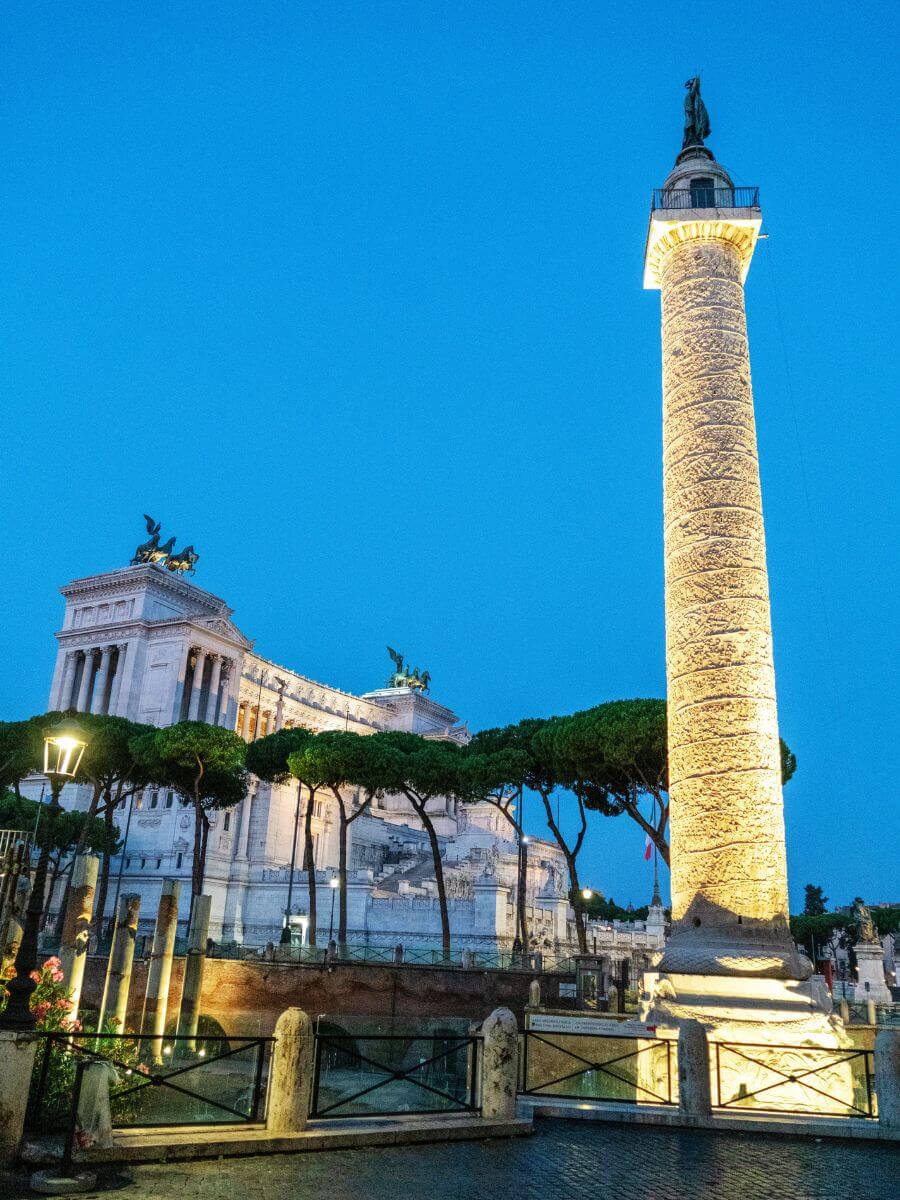
The Incredible Details of Trajan’s Column
When you stop to admire Trajan’s Column in Rome, take a moment to get close, every inch of marble tells a story. It’s one of those ancient monuments you can look at a hundred times and still discover something new each visit, so rich in detail and symbolism.
The Spiral Frieze: A Masterpiece of Storytelling in Stone
This is what makes Trajan’s Column so famous, a spiral frieze nearly 200 meters long that wraps around the entire shaft. Along this carved ribbon, more than 2,500 figures come to life in over a hundred scenes, illustrating the two great military campaigns of Emperor Trajan against the Dacians.
At the time, most Romans didn’t read the official chronicles, so this frieze served as a story told in images, a sort of giant marble comic strip that everyone could understand. Starting from the bottom, you can follow the entire sequence: soldiers preparing for war, building bridges and camps, marching into battle, and finally celebrating Rome’s victory.
And because Roman artists were true masters of visual design, the bands gradually widened toward the top, ensuring that even the highest scenes remained visible from the ground. Not bad for a monument carved in 113 AD, right?
Originally, the frieze wasn’t the pale marble we see today. The reliefs were painted in bright colors, red, blue, and gold, that made every scene stand out dramatically. Though time has erased those pigments, it’s easy to imagine how spectacular the column must have looked in all its colorful glory.
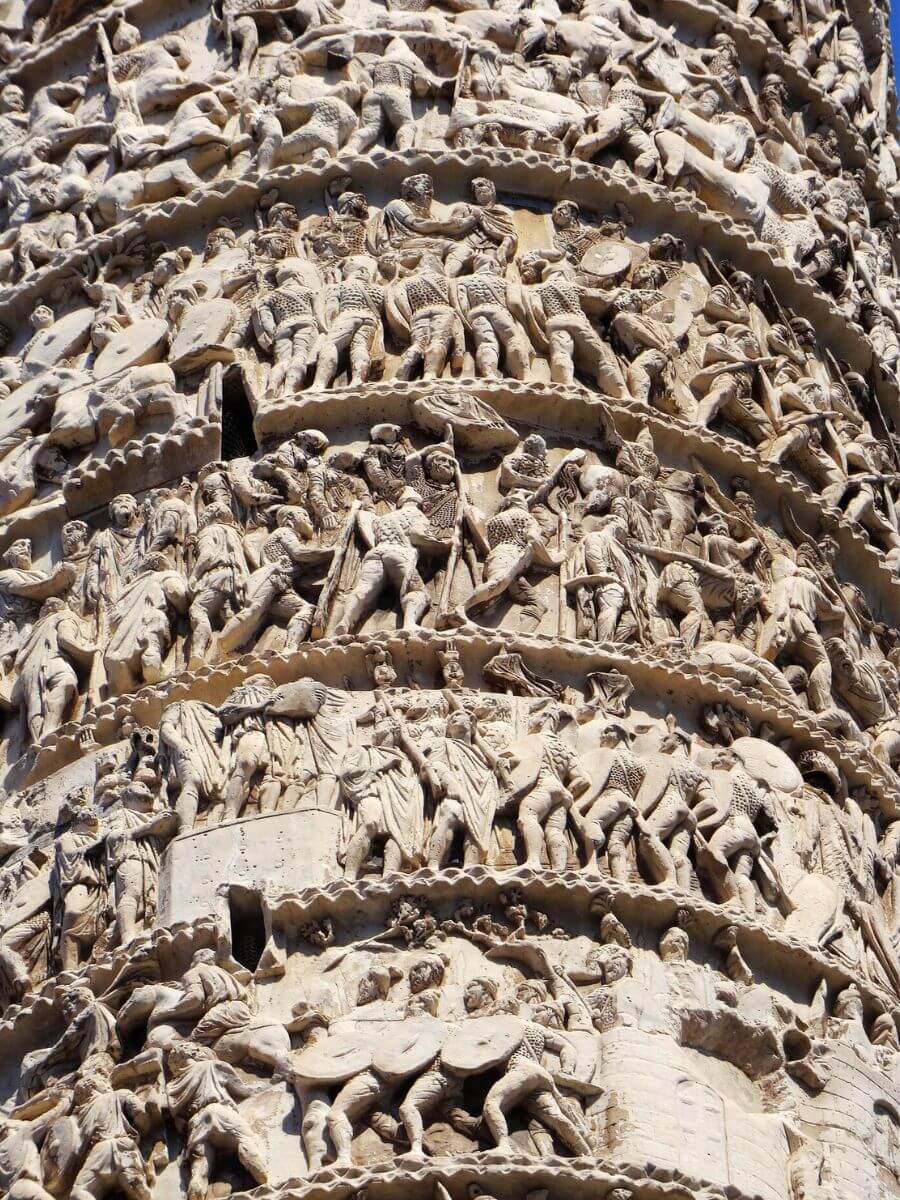
Architecture and Dimensions of Trajan’s Column
While the spiral frieze steals the spotlight, the architecture and proportions of Trajan’s Column are just as remarkable. The monument stands about 40 meters tall (including the base), roughly the height of a 12-story building! The shaft alone measures 29.8 meters, with a diameter of around 3.8 meters.
What’s truly fascinating, though, is how it was built. The column is made up of between 17 and 29 blocks of Parian marble, each weighing up to 70 tons. These massive blocks were fitted together with astonishing precision, a feat that still amazes engineers and archaeologists today.
To make the reliefs more visible from the ground, the column’s shaft bulges slightly near the upper third, a clever optical adjustment designed to counteract perspective distortion. Yes, the Romans already understood the secrets of optics and architectural staging nearly two millennia ago!

The Statues at the Top of Trajan’s Column
At the very top, the column was originally crowned with a gilded bronze statue of Emperor Trajan, several meters high, watching symbolically over his city. Over time, the statue was lost, and in 1587, Pope Sixtus V replaced it with a statue of Saint Peter, which still stands there today, proudly overlooking Rome.
This transformation gave the monument a Christian touch, but it did nothing to diminish its ancient grandeur. When you realize that this masterpiece has been standing for nearly 2,000 years, it’s easy to understand why the Column of Trajan in Rome is considered one of the greatest sculptural achievements of the Roman world.
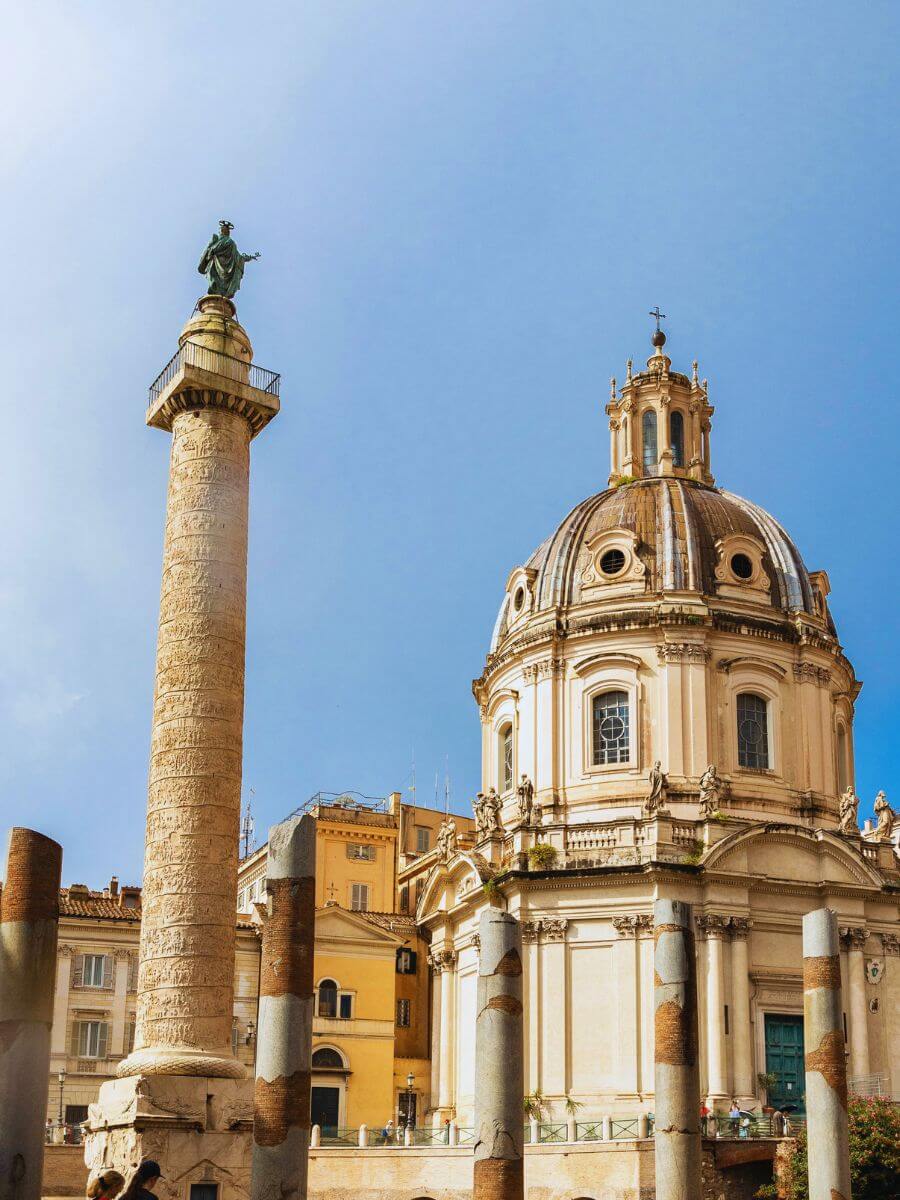
A Triumphal and Funerary Monument
What makes Trajan’s Column in Rome so fascinating is that it doesn’t just celebrate a military victory, it embodies both the glory and the memory of an emperor.
When it was first built, the column had a triumphal purpose. It commemorated Trajan’s victorious campaigns against the Dacians, but it also glorified Rome itself, its army, its empire, and its extraordinary architectural genius. The carved reliefs served as a grand visual backdrop to this imperial celebration. As Romans walked through the Forum of Trajan, they could gaze upon these scenes and feel the might of their empire come to life.
But beyond its political and symbolic message, the column also had a funerary function. When Emperor Trajan died in 117 AD, his ashes were placed inside a golden urn and sealed within a small chamber at the base of the monument. This made the column an imperial tomb, a truly unique event in Roman history, as no emperor before him had ever been buried within the city walls.
This choice was deeply meaningful. It turned the column into a place of memory and continuity, linking Trajan’s military triumphs to his lasting spiritual legacy. The inscription carved on the pedestal captures this idea perfectly: it states that the height of the column corresponds to the height of the hill that was leveled to build the forum, a symbol of the emperor’s monumental achievements.
In this way, Trajan’s Column fulfilled three purposes in one masterpiece:
- To commemorate the power and conquests of Rome.
- To honor the emperor as a deified hero.
- To preserve his memory for eternity as a sacred burial site.
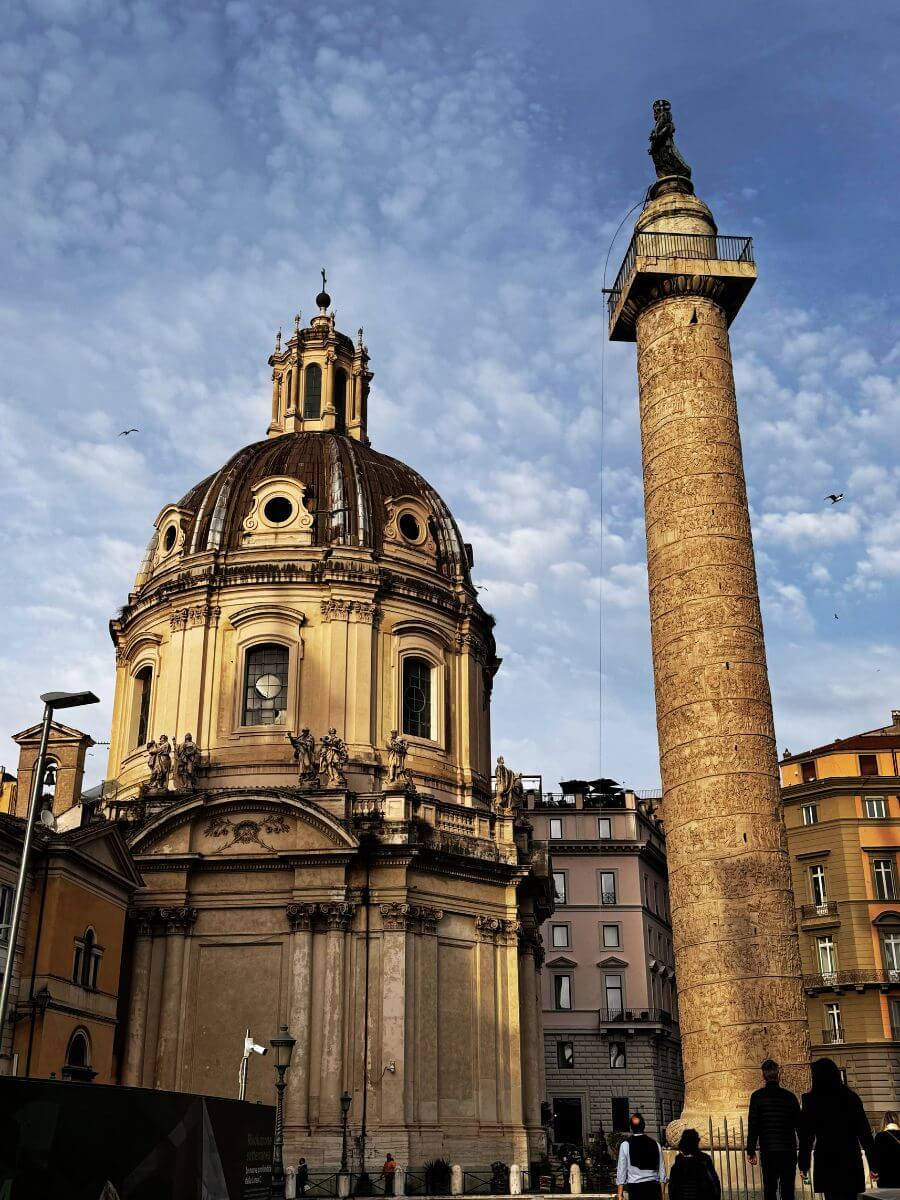
History of Trajan’s Column Through the Centuries
Built between 107 and 113 AD, Column of Trajan has stood tall for nearly two millennia without ever losing its majesty. It was designed by Apollodorus of Damascus, one of the greatest architects of ancient Rome, the same genius behind the Basilica Ulpia and the famous Bridge of Trajan over the Danube.
From the Roman Empire to Late Antiquity
When it was inaugurated in 113 AD, the column stood proudly at the center of the Forum of Trajan, surrounded by two grand libraries, one Greek and one Latin. These buildings even had balconies specially designed so visitors could admire the intricate details of the spiral frieze high above the ground. Imagine the spectacle!
Throughout the imperial period, the monument remained a symbol of prestige and a landmark in Rome’s cityscape. Even after Trajan’s death, the column continued to serve as a commemorative structure. His successor, Emperor Hadrian, built a temple in Trajan’s honor nearby, reinforcing the emperor’s legacy.
The Middle Ages: A Survivor of Time
When the Roman Empire collapsed, countless ancient monuments were destroyed or dismantled for their materials. But Trajan’s Column in Rome miraculously escaped this fate. Why? According to legend, Trajan’s soul was saved by the prayers of Pope Gregory the Great, which spared the monument from being torn down.
This belief protected the column at a time when many pagan symbols were being erased, allowing it to survive the Middle Ages almost completely intact.

The Renaissance and Modern Era
During the Renaissance, artists rediscovered the Column of Trajan with renewed admiration. The great sculptor Bernini himself once said that the column was “the source from which all great men drew the strength and grandeur of their vision.” That gives you an idea of its influence!
A small chapel dedicated to Saint Nicholas was even built against the monument for several centuries before being demolished around 1500. Later, in 1587, Pope Sixtus V ordered that the statue of Emperor Trajan at the top be replaced with one of Saint Peter, to further Christianize the ancient monument. That’s the same statue you can still see today, proudly overlooking the Via dei Fori Imperiali.
From Napoleon to the Present Day
In the 19th century, Napoleon III even considered transporting the column to Paris. It was an ambitious dream, but ultimately an impossible one. With its dozens of marble blocks weighing up to 70 tons each, the logistics were simply unfeasible. Instead, plaster casts of the reliefs were made for study and display in various European museums.
In more recent times, the column has undergone several restoration and cleaning campaigns, particularly in the 20th century and early 2000s. These efforts helped restore the brilliance of the marble and protect the sculpted reliefs from damage caused by pollution and time.
Today, Trajan’s Column remains not only a symbol of Ancient Rome, but also a must-see landmark for visitors and a source of inspiration for historians and artists alike. Few monuments in the world can boast of having survived twenty centuries while keeping so many of their original details intact.
What to See Near Trajan’s Column in Rome
Trajan’s Column doesn’t stand alone, it’s right in the heart of one of the most fascinating archaeological areas in Rome. Look up, and you’ll literally be surrounded by 2,000 years of history!
Here are 7 must-see sites just steps away from the column:
- Trajan’s Forum : The column is part of the magnificent Forum of Trajan, once surrounded by libraries and the Basilica Ulpia. You can still admire the ruins today and imagine what this vast imperial complex looked like in the 2nd century AD, a true masterpiece of Roman urban planning.
- Trajan’s Market (Mercati di Traiano) : Just behind the column, this impressive brick complex is often considered the world’s oldest shopping mall. It now houses the Museum of the Imperial Forums, featuring sculptures, architectural models, and stunning panoramic views of the column from its terraces.
- The Twin Churches of Santa Maria di Loreto and Santissimo Nome di Maria : These two perfectly symmetrical Baroque churches frame the column beautifully, creating one of the most photographed panoramas in Rome. Step inside Santa Maria di Loreto if you have time, its marble details and frescoes are worth a quick visit.
- Altar of the Fatherland (Victor Emmanuel II Monument) : This gigantic white-marble monument dominates Piazza Venezia. Take the elevator to the panoramic terrace for a breathtaking view over the Column of Trajan and the surrounding forums, especially striking at sunset.
- Forum of Caesar and Forum of Augustus : Walking along Via dei Fori Imperiali, you’ll come across the remains of the earliest Roman forums. Visit in the evening if you can, the illuminated ruins create a magical atmosphere, perfect for an evening stroll through history.
- Roman Forum and Colosseum : Just a 10-minute walk away, these two icons of ancient Rome are the perfect next stop. A combined ticket gives you access to the Colosseum, the Roman Forum, and Palatine Hill, an ideal way to complete your journey through imperial Rome.
- Capitoline Museums : Perched on the nearby Capitoline Hill, these museums house some of the world’s most important collections of ancient art. Don’t miss the terrace view, which offers an unforgettable perspective over Trajan’s Column and Trajan’s Forum, especially at golden hour.
FAQ About Trajan’s Column in Rome

Can you go inside Trajan’s Column?
No, the column can’t be visited from the inside. It’s hollow and contains a spiral staircase, but access is restricted for conservation reasons.
How tall is Trajan’s Column?
It stands about 40 meters high, including its base — roughly the height of a 12-story building.
How many blocks make up the Column of Trajan?
The column is made of 17 massive blocks of Carrara marble, each weighing up to 70 tons.
How has the Column of Trajan been preserved so well?
Its remarkable state of preservation is due to its integration into Rome’s urban landscape and the protection it received since the Middle Ages, especially after being Christianized.
What does the frieze on Trajan’s Column represent?
The spiral frieze depicts, from bottom to top, Trajan’s two military campaigns against the Dacians between 101 and 106 AD.
Who replaced the statue of Trajan at the top of the column?
In 1587, Pope Sixtus V replaced the emperor’s statue with one of Saint Peter, which still crowns the monument today.
How many figures appear on the Column of Trajan?
The frieze features around 2,500 sculpted figures, including Emperor Trajan, who appears over 60 times throughout the scenes.
Fanny is a music and travel lover who has been visiting Rome since 2012. She is the founder and main editor of the Roma Pass blog and she like to share the best things to do in Rome.
